Published on
Updated on
Contents:
- The 2023 Grape Vintage and Weather Impacts
- Asynchronous Flowering and Fruit Development
- Midwest Fruit Pest Management Guide 2023-24
- Vineyard Irrigation
- Other Grapevine Stresses on the Horizon: Synthetic Auxin Herbicide Drift
- Spotted Lanternfly (SLF) Update
- Cumulative Growing Degree Days for the Seven Grape Growing Regions of Missouri from April 1 to May 26, 2023
The 2023 Grape Vintage and Weather Impacts
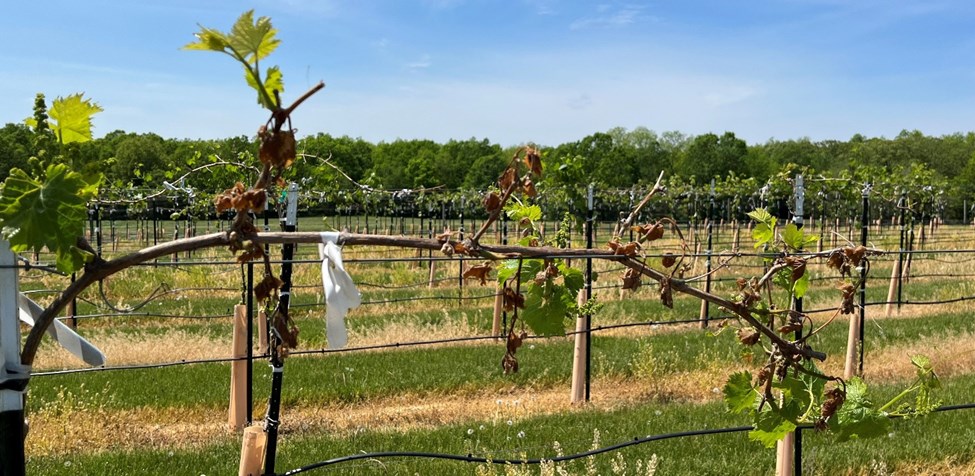
Photo credit: Dean S. Volenberg, May 25, 2023.
A number of factors played a role in reduced production of the 2023 Missouri grape vintage. The first factor was an extremely early killing frost last fall. The frost occurred prior to the completion of harvest in some areas. With no leaves on the vines at or near harvest carbohydrates are not produced and then stored within the grapevine trunk, cordons and spurs and roots. The early fall frost was more detrimental on late harvested cultivars such as Chambourcin and Norton. Second, air temperatures fluctuated greatly during the last three months of 2022. Ideally, temperatures would cool down gradually. The grapevines then would acclimate to these colder temperatures. However, when temperatures rise significantly above freezing the grapevines do not acclimate as well to future colder temperatures. Third, extreme cold temperatures occurred on Dec. 22 and 23, 2022. I believe these temperatures caused death to a large percentage of primary count buds. Primary bud damage was greatest in the cultivars Chambourcin and Chardonel. Other severely damaged cultivars were Cayuga. Lastly, late April frost events occurred after bud break and shoot development causing more fruit loss. There are vineyard sites that escaped some of the events described above, but most all sites across Missouri experienced primary bud damage in late December 2022.
Working on Relief
Some state agencies have been informed of the losses of the Missouri grape growers. We are working with state partners to find programs that can help Missouri Grape Growers. I envision that recent frost events in the eastern part of the country and specifically impacting the New York wine grape industry may potentially spur federal agencies to become involved. As more information becomes available I will keep you informed.
Asynchronous Flowering and Fruit Development
The 2023 grape vintage had asynchronous flowering. This resulted from flowering on primary buds that remained undamaged by climate events and flowering on secondary buds when primary buds were damaged by climate events. In essence there are two age classes of clusters on most grapevines. This will result in some clusters lagging behind in terms of developing age-related resistance to powdery mildew, black rot and downy mildew. In regards to protecting the fruit, another application of fungicides should be applied to protect this lagging fruit produced from secondary buds.
In a normal year, an immediate pre-bloom fungicide application is followed by a post-bloom fungicide application. This season we have a lagging class of fruit developing from secondary buds. Be aware that the grape berries are highly susceptible to fungal infections until the berries are approximately 6-weeks post bloom.
Midwest Fruit Pest Management Guide 2023-24
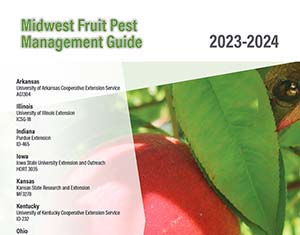
A pdf of the 2023-2024 Guide is available online at Midwest Fruit Pest Management Guide.
Vineyard Irrigation
Consider checking your irrigation systems prior to needing to use it. Areas of severe to extreme drought are increasing weekly. Approximately 20% of the land area in Missouri is in a severe to extreme drought. Drought stress on grapevines is considered one of the triggers for the development of trunk diseases. Grapevine trunk diseases are very different compared to the foliar diseases of grapevines. Trunk disease microorganisms are endophytic. The grapevine and the endophytic microorganism can live in harmony together and the endophytic microorganism does no harm to the grapevine initially.
The endophytic microorganism at some point becomes a pathogen and starts to cause harm to the semi-permanent wood (trunk, cordon, and spurs). The change from friend to foe by the endophytic micro-organism is believed to result from vine stress(es). These stresses can include saturated soils, drought and cold winter temperatures. Missouri being a continental climate experiences cold temperatures, drought and saturated soil conditions.
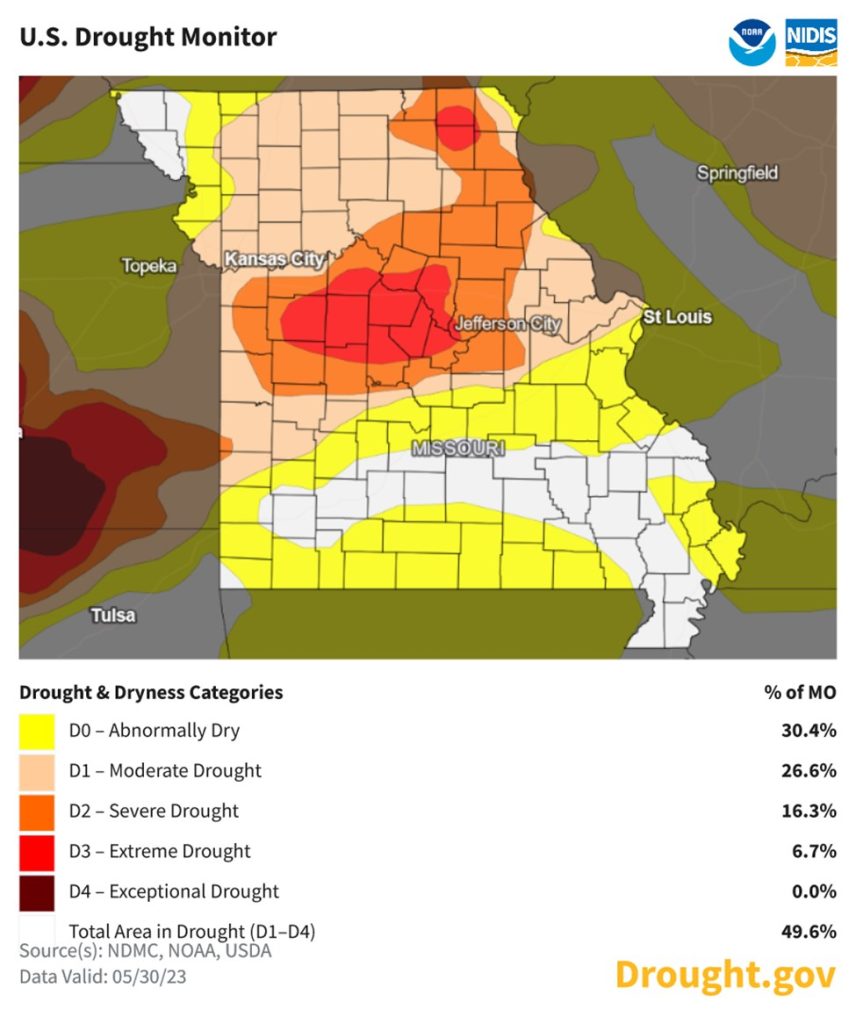
Other Grapevine Stresses on the Horizon: Synthetic Auxin Herbicide Drift

When rain does return to areas of Missouri, weeds will follow and this will likely result in the application of synthetic auxin herbicides such as dicamba for weed control in soybeans. Dicamba can be applied to dicamba tolerant soybeans through June 30. If you observe damage from synthetic auxin herbicides in your vineyard, consider reporting the incident to the Missouri Department of Agriculture. Online Pesticide Incident Report
Prior to filling out the Online Pesticide Report, please call The Bureau of Pesticide Control at 573-751-5504 and provide an oral report. Note the name of the person to whom you spoke.
For more information on herbicide drift and documenting the damage, please see Herbicide Drift: What to do?
Spotted Lanternfly (SLF) Update
As of June 1, 2023, SLF is not present in Missouri. Since 2022, SLF infestations have not moved further west from Indiana. However, SLF was reported last fall in Iowa. The two adult SLF identified in Iowa were determined to be hitchhikers and so at this time infestations of SLF are not present in Iowa.
Please keep your employees informed of SLF and provide them resources to identify SLF. At this time of year SLF are in the nymph stage (Figure 1) and over time will develop into adults (Figure 2). Nymphs of SLF are wingless and are black with white spots. The last nymph stage prior to becoming an adult SLF is red with white and black spots (Figure 1).
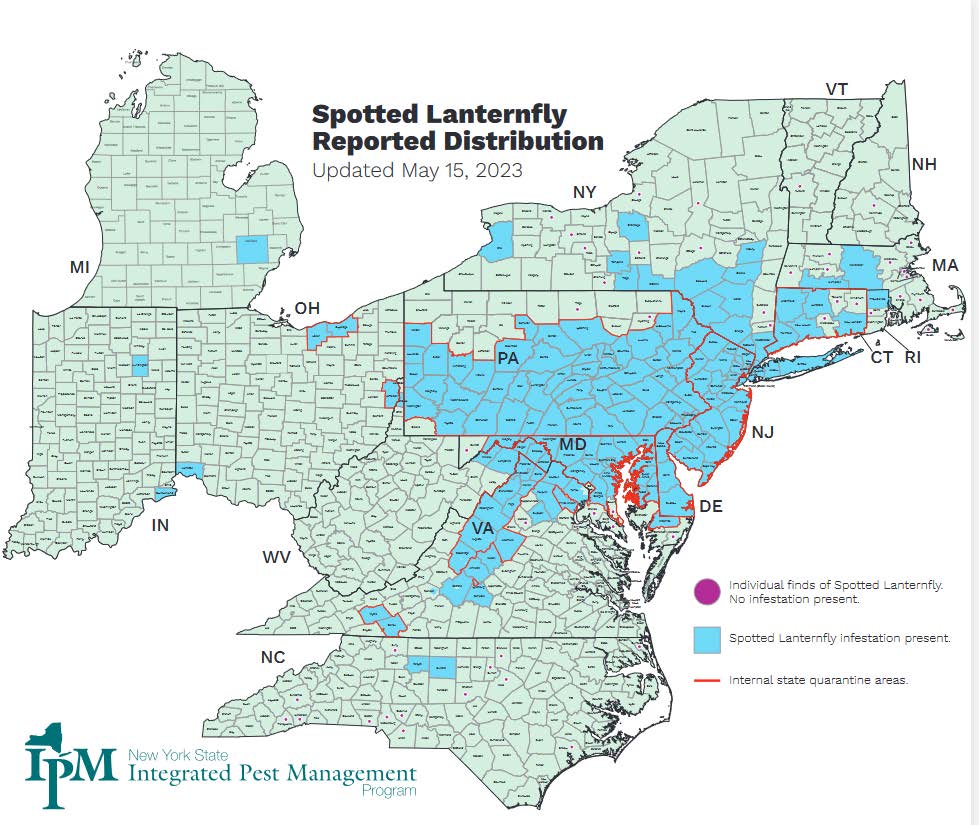
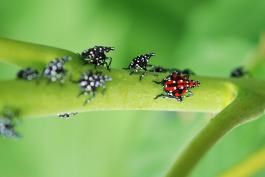

Map (Left). Click photo to enlarge.
Figure 1 (Middle). Nymphs of Spotted Lanternfly are black with white spots. During the last nymph development stage the nymph is red with white and black spots. At this time of year, SLF will be nymphs. By mid-summer, the nymphs will become adults. Photo credit: Lawrence Barringer, Pennsylvania Department of Agriculture, Bugwood.org
Figure 2 (Right). Adult of Spotted Lanternfly. The adult SLF is the life stage that is often found hitchhiking to new sites. Adults can fly, but SLF is a large planthopper and adult SLF are often observed hopping instead of flying. Adult SLF life stage begins in mid summer and continues until a killing freeze Photo credit: Lawrence Barringer, Pennsylvania Department of Agriculture, Bugwood.org
Cumulative Growing Degree Days for the Seven Grape Growing Regions of Missouri from April 1 to May 26, 2023
| Region | Location by County | Growing Degree Days1 | ||
|---|---|---|---|---|
| 2023 | 2022 | 30-year Average | ||
| Augusta | St. Charles | 736 | 645 | 646 |
| Hermann | Gasconade | 683 | 599 | 619 |
| Ozark Highland | Phelps | 759 | 648 | 687 |
| Ozark Mountain | Lawrence | 740 | 652 | 670 |
| Southeast | Ste. Genevieve | 708 | 669 | 693 |
| Central | Boone | 708 | 589 | 615 |
| Western | Ray | 689 | 569 | 593 |
1 Growing degree days at base 50 from April 1 to May 26, 2023. Data compiled from Useful and Useable at U2U Decision Tool -Corn GDD.
To determine the number of growing degree days accumulated in your area since April 1, use this tool.
Please scout your vineyards on a regularly scheduled basis in an effort to manage problem pests. This report contains information on scouting reports from specific locations and may not reflect pest problems in your vineyard. If you would like more information on IPM in grapes, please contact Dean Volenberg at 573-882-0476 (office) 573-473-0374 (mobile) or volenbergd@missouri.edu